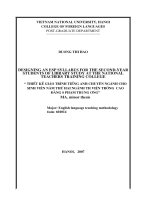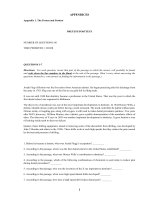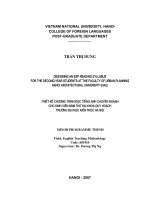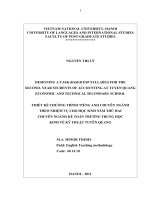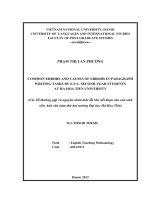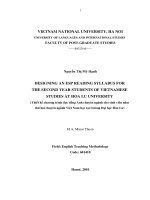Evaluating an ESP blended learning program for second year students majoring in chemistry in a university in hanoi
Bạn đang xem bản rút gọn của tài liệu. Xem và tải ngay bản đầy đủ của tài liệu tại đây (451.01 KB, 87 trang )
VIETNAM NATIONAL UNIVERSITY, HANOI UNIVERSITY OF
LANGUAGES AND INTERNATIONAL STUDIES FACULTY OF POSTGRADUATE STUDIES *********************
ĐÀO THỊ HOA
EVALUATING AN ESP BLENDED LEARNING PROGRAM FOR SECONDYEAR STUDENTS MAJORING IN CHEMISTRY IN A UNIVERSITY IN
HANOI
ĐÁNH GIÁ CHƯƠNG TRÌNH HỌC TIẾNG ANH CHUYÊN NGÀNH THEO
MÔ HÌNH KẾT HỢP TRỰC TIẾP- TRỰC TUYẾN DÀNH CHO SINH VIÊN
NĂM THỨ HAI CHUYÊN NGÀNH HÓA HỌC TẠI MỘT TRƯỜNG ĐẠI
HỌC Ở HÀ NỘI
M.A MINOR PROGRAM THESIS
Field: ELT Methodology
Code: 8140231.01
HANOI – 2019
VIETNAM NATIONAL UNIVERSITY, HANOI UNIVERSITY OF
LANGUAGES AND INTERNATIONAL STUDIES FACULTY OF POSTGRADUATE STUDIES *********************
ĐÀO THỊ HOA
EVALUATING AN ESP BLENDED LEARNING PROGRAM FOR SECONDYEAR STUDENTS MAJORING IN CHEMISTRY IN A UNIVERSITY IN
HANOI
ĐÁNH GIÁ CHƯƠNG TRÌNH HỌC TIẾNG ANH CHUYÊN NGÀNH THEO
MÔ HÌNH KẾT HỢP TRỰC TIẾP- TRỰC TUYẾN DÀNH CHO SINH VIÊN
NĂM THỨ HAI CHUYÊN NGÀNH HÓA HỌC TẠI MỘT TRƯỜNG ĐẠI
HỌC Ở HÀ NỘI
M.A MINOR PROGRAM THESIS
Field: ELT Methodology
Code: 8140231.01
Supervisor: Trần Thị Thu Hiền, Ph.D
HANOI – 2019
DECLARATION
I
hereby
declare
that
the
minor
thesis
submitted
today
entitled:
“Evaluating an ESP blended learning program for second-year students
majoring in Chemistry in a university in Hanoi” is the result of my own work,
except where reference is made in the text of the thesis. The work contained in this
thesis has not been previously submitted for a higher degree in any other education
institution.
Dao Thi Hoa
September, 2019
i
ACKNOWLEDGEMENTS
During the period of completing the Master thesis, I have received the support of a
great number of people.
First and foremost, I would like to express my deepest gratitude to my supervisor,
Ms. Tran Thi Thu Hien, Ph.D for her patient guidance, detailed suggestions,
excellent support, great encouragement and constructive supervision during the
research project.
I also wish to express my great thanks to all the professors and lecturers at the
University of Languages and International Studies, Vietnam National University, for
their insightful lectures, their invaluable assistance, and guidance during learning
the Master program.
I am indebted to the university where I work, my colleagues, and my students who
participated in this study. For ethical reasons, I cannot mention their names here, yet
I wish to warmly thank them for their interest and support for my study. Without
their participation, this study would not have come into being.
Finally, I would like to express my heartfelt thanks to my family and my friends for
their long-term support and encouragement from the beginning to the end of the
research process. My parents, my husband, and my daughter have happily shared all
the ups and downs of my research journey. I could not have sustained and
completed this difficult journey without their support and unconditional love.
Dao Thi Hoa
ii
ABSTRACT
The continual growth of technology enhances the development of English teaching
and learning, especially ESP blended learning programs in higher education, which
can improve the communicative environments for Vietnamese students. However,
the effectiveness of this program is not clearly recognized. This paper aims at
evaluating the effectiveness of an ESP blended learning program for second-year
students majoring in Chemistry in a university in Hanoi, finding the difficulties
which teachers and students have to encounter during teaching and learning this
program. Based on which some recommendations were suggested to design a better
learning and teaching program.
This paper is a survey research project identifying learner evaluation towards the
effectiveness of an ESP blended learning program as well as teacher evaluation of
the program through their learning and teaching experience. The author conducted a
survey questionnaire at Chemistry department of a university in Hanoi with 55
student respondents. Also, the researcher interviewed 5 English teachers who are in
charge of teaching English for these students. The results revealed that the students‟
perceptions and attitudes towards the effectiveness of blended learning program
were positive in terms of the four domains in the questionnaire: (i) online learning
parts, (ii) face-to-face lessons, (iii) online and face-to-face integration, and (iv)
learners‟ outcomes. However, regarding implementing ESP blended learning for the
second-year students in the Chemistry department, some negations are openly
acknowledged. In addition, possible suggestions are proposed for enhancing the
effectiveness of such program.
iii
TABLE OF CONTENTS
DECLARATION...................................................................................................... i
ACKNOWLEDGEMENTS.................................................................................... ii
ABSTRACT............................................................................................................ iii
LIST OF FIGURES............................................................................................... vii
LIST OF TABLES................................................................................................ viii
CHAPTER 1- INTRODUCTION.......................................................................... 1
1.1. Rationale for the study..................................................................................... 1
1.2. Aims and objectives of the study..................................................................... 2
1.3. Research questions........................................................................................... 2
1.3. Methods of the study........................................................................................ 3
1.4. Scope of the study............................................................................................ 3
1.5. Significance of the study.................................................................................. 3
1.6. Structure of the thesis....................................................................................... 3
Chapter 2- LITERATURE REVIEW.................................................................... 5
2.1. English for Specific Purposes (ESP)............................................................. 5
2.1.1. Definition of ESP............................................................................................. 5
2.1.2. Characteristics of ESP.................................................................................... 6
2.1.3. Types of ESP.................................................................................................... 7
2.1.4. English for General Purposes (EGP) versus English for Specific Purposes
(ESP)8
2.2. Blended learning............................................................................................ 9
2.2.1. Definition of blended learning......................................................................... 9
2.2.2. Benefits of blended learning.......................................................................... 10
2.2.3. Requirements of implementing blended learning........................................... 11
2.3. Program evaluation..................................................................................... 12
2.3.1. Definition of program evaluation.................................................................. 12
2.3.2. Blended learning evaluation.......................................................................... 13
2.3.3. Purposes of program evaluation................................................................... 15
2.3.4. Program evaluators....................................................................................... 16
iv
2.4. Previous studies related to the thesis.......................................................... 17
2.5. Chapter summary........................................................................................ 20
CHAPTER 3- METHODOLOGY....................................................................... 21
3.1. The participants........................................................................................... 21
3.1.1. Students......................................................................................................... 21
3.1.2. Teachers........................................................................................................ 21
3.2. Research setting........................................................................................... 21
3.3. Research questions....................................................................................... 23
3.4. Research methods........................................................................................ 23
3.5. Data collection instruments......................................................................... 25
3.5.1. Questionnaire................................................................................................ 25
3.5.2. Interview........................................................................................................ 27
3.6. Data collection procedure............................................................................ 27
3.6.1. Questionnaire................................................................................................ 27
3.6.2. Interview........................................................................................................ 28
3.7. Data analysis procedure.............................................................................. 29
3.7.1. Analysis of the survey questionnaire.............................................................. 29
3.7.2. Analysis of the interview................................................................................ 29
3.8. Chapter summary........................................................................................ 30
CHAPTER 4- DATA ANALYSIS AND FINDINGS............................................ 31
4.1. The effectiveness of the ESP blended learning program........................... 31
4.1.1. Online learning parts................................................................................... 31
4.1.1.1.
Students’ evaluation on online learning parts......................................... 31
4.1.1.3.
Teachers’ evaluation on online learning parts........................................ 32
4.1.2. Face-to-face lessons..................................................................................... 34
4.1.2.1.
Students’ evaluation on face-to-face lessons........................................... 34
4.1.2.2.
Teachers’ evaluation on face-to-face lessons.......................................... 36
4.1.3. The integration between online learning and face-to-face lessons.............37
4.1.3.1.
Students’ evaluation on the integration between online learning and face-
to-face lessons......................................................................................................... 37
v
4.1.3.2.
Teachers’ evaluation on the integration between online learning and
face-to-face lessons ...................................................................................................
4.1.4. Students’ outcomes .........................................................................................
4.1.4.1. Students’ evaluation on their outcomes ...................................................
4.1.4.2. Teachers’ evaluation on students’ outcomes ...........................................
4.1.5. Learners’ expectation ......................................................................................
4.2.
Students and teachers’ difficulties encountered during
4.2.1. Students’ difficulties ........................................................................................
4.2.2. Teachers’ difficulties .......................................................................................
4.3.
Suggestions and implications ...........................................
4.3.1. The teachers and students’ suggestions to improve the ESP blended
learning program......................................................................................................
4.3.1.1.
Learners’ suggestions .........
4.3.1.2.
Teacher’s suggestions .........
4.3.2. Implications for a better ESP blended learning program ............................
4.3.2.1.
Implications for students ....
4.3.2.2.
Implications for teachers ....
4.3.2.3. Implications for university authorities .....................................................
4.4.
Discussion ..........................................................................
4.5.
Chapter summary .............................................................
CHAPTER 5- CONCLUSION ...............................................................................
5.1.
Recapitulation ...................................................................
5.2.
Limitations and suggestions for further studies .............
5.2.1. Limitations .......................................................................................................
5.2.2. Suggestions for further studies ........................................................................
REFERENCES ........................................................................................................
APPENDICES ...........................................................................................................
Appendix A: SURVEY QUESTIONNAIRE FOR STUDENTS ...........................
Appendix B: TEACHERS’ INTERVIEW QUESTIONS ...................................
vi
LIST OF FIGURES
Figure 2.1: Four puzzle pieces of evaluation (Pombo and Moreira, 2011)..................14
Figure 4.1: Students‟ evaluation of online learning parts.................................................. 31
Figure 4.2: Students‟ evaluation on face-to-face lessons................................................... 34
Figure 4.3: Students‟ evaluation on the integration between online and face-to-face
37
Figure 4.4: Students‟ evaluation on their outcomes............................................................. 40
Figure 4.5: Learners‟ expectation of the ESP blended learning course....................... 42
vii
LIST OF TABLES
Table 2.1: ESP characteristics Dudley-Evans and St. John (1998)............................6
Table 2.2: Types of ESP, Dudley-Evans, T. & John, M.J. (1998 pp.34-73)..............7
viii
CHAPTER 1- INTRODUCTION
1.1.
Rationale for the study
It is undeniable that Information and Communication Technologies (ICTs)
nowadays plays a crucial role in human being‟s life in general and education in
particular. The increased integration of ICTs in teaching and learning has become
more familiar with higher education in Vietnam and led to a deeper interest in
enhanced interactions between students and their teachers, peers and learning
materials. As a result, blended learning, defined as “the organic integration of
thoughtfully selected and complementary face-to-face and online approaches and
technologies.” (Garrison & Vaughan, 2008), has been becoming a popular method
in higher education because it not only helps improve teaching methodologies but
also changes students‟ ways of learning. However, the main issues here are to what
extent blended learning is effective.
“Blended learning is typically more complicated and multifaceted than either fully
online or face-to-face learning….” (Bonk, Kim, and Zheng, 2004). The application
of the blended learning program enables students to learn a wide variety of
knowledge and then apply them into inside English class activities. In particular, the
combination of online learning and face-to-face class environment gives chances for
teachers to provide students with rich language input and opportunities for students
to learn online and focus on facilitating students‟ interactive and collaborative
learning in face-to-face classes. For example, students learning online at home will
have material for their face-to-face classes and then have more time to apply these
materials into improving speaking. Therefore, the combination of online and faceto-face learning creates opportunities for students to develop their English
knowledge and skills as well.
Blended learning program provides an ideal environment for language education, so
it becomes more familiar with higher education in Vietnam. The university where
the study is conducted is one of the first universities applying blended learning in
1
teaching English. The implementation of blended learning is expected to enable
teachers to improve their teaching methodology to facilitate students‟ development
of English ability for social and professional communication, as well as their
lifelong learning skills. To achieve these purposes, teachers teaching in blended
learning courses are required to understand blended learning, take part in designing
curriculums and material processes. Although the university has applied blended
learning in teaching English there since 2015, there has not been any research into
evaluate the effectiveness of this teaching program. It is necessary to discover the
answer to this matter. Basing on the results, recommendations can be proposed to
improve the quality of this program at the university. A deep understanding of the
effectiveness of blended learning environment will provide the opportunity to
improve students‟ English as well as teachers‟ teaching methods in implementation
of blended learning in English language teaching at the university.
1.2.
Aims and objectives of the study
The study aims at evaluating the effectiveness of an ESP blended learning program
for second-year students majoring in Chemistry in a University in Hanoi. Its
interrelated objectives are:
-
To investigate the effectiveness of the ESP blended learning program for
second year students majoring in Chemistry in a university in Hanoi from the
students and teachers’ perspectives;
-
To find out difficulties encountered by teachers and students during their
teaching and learning time in this ESP blended learning program.
1.3.
Research questions
The study was carried out to obtain information for answering the following
research questions:
1.
How effective is the ESP blended learning program for second-year
students in Chemistry Department from the teachers and students’
perspectives?
2.
What are difficulties encountered by teachers and students during
their teaching and learning time in this ESP blended learning program?
2
1.3.
Methods of the study
To serve its purpose, this study has been conducted as survey research using
questionnaires and interviews to collect data. Fifty-five second-year students, who
are either taking or have just completed the ESP blended learning course have
participated in filling the questionnaire. Five teachers teaching the ESP blended
learning program have been interviewed.
The data obtained from the questionnaire was analyzed quantitatively and
qualitatively to identify the common patterns of responses regarding the
effectiveness of such program. The answers from the interviews were analyzed to
identify the teachers‟ evaluation of the program and their suggestions for improving
this program.
1.4. Scope of the study
The study is conducted to evaluate the effectiveness of ESP blended learning for
second-year students majoring in Chemistry in a university in Hanoi from the
perspectives of teachers and students experiencing this program. All other studies
aim at evaluating other programs for other types of students are out of the scope of
the study.
1.5.
Significance of the study
In theory, this study will contribute to blended learning program to some extent.
The evaluation of the program will show its effectiveness and propose some
possible suggestions to improve such program. Therefore, the result of the study is
the material for teachers teaching ESP blended learning at this university in
particular and for teachers and students attending ESP blended learning in general
to implement a successful ESP blended learning program in the future.
1.6.
Structure of the thesis
Chapter 1: Introduction presents the rationale, objectives, research questions,
methodology, scope, significance, and structure of the thesis.
3
Chapter 2: Literature review has three main parts. The first part provides some
theoretical background about the definition of ESP, types and characteristics of ESP,
the differences between EGP and ESP. The second part is about the definition,
characteristics of blended learning and requirements in implementing blended
learning program. The last part focuses on program evaluation including definition
of program evaluation, the purposes of program evaluation, and program evaluators,
the evaluation of blended learning, and the evaluation of an ESP course. Last but not
least, a brief summary of some existing relevant studies is also presented in this
chapter.
Chapter 3: Methodology works with the introduction of research methods
including research questions, data collection instruments, data collection procedure.
Chapter 4: Findings and discussion chapter shows the procedure of carrying out the
research and presents the data analysis, which results from analyzing questionnaire
and interview.
Chapter 5: Conclusion followed by references is the last chapter which is the
summary of the whole study. The limitations of the study and suggestions for
further study are also mentioned on the last pages of the paper.
4
Chapter 2- LITERATURE REVIEW
This chapter offers a review ESP and blended learning program and the literature
related to program evaluation. In each section, the definition, is presented together
with some related features of each term. Besides, the previous studies are also
mentioned in the last part of this chapter.
2.1.
English for Specific Purposes (ESP)
2.1.1. Definition of ESP
The term ESP has quite a lot of definitions from various authors.
ESP focuses on the specific needs of the learners and includes the skills and
competencies of language usage in different contexts.
According to Hutchinson and Waters (1987), it is “not the existence of a need, but
rather an awareness of the need” that sets ESP apart from General English.
The other approach of ESP is to focus on restricted language repertoire, teaching
terms, and specific discourse (Huckin, 2003; Hyland, 2003).
ESP is also defined as “the role of English in a language course or programme of
instruction in which the content and aims of the course are fixed by the specific
needs of a particular group of learners” (Richards and Schmidt, 2010, p. 198).
According to Brown (2016, p.5), ESP is fundamentally linked to “the specific needs
of a particular group of learners,” or “put another way, if there is no needs analysis,
there is no ESP.”
Widdowson (1983, p.5) defined “ESP is essentially a training operation which seeks
to provide learners with a restricted competence to enable them to cope with certain
clearly defined tasks. These tasks constitute the specific purposes which the ESP
course is designed to meet.”
As definitions are mentioned above, ESP courses should have the distinctive
features from General English course of skills, themes, situations, functions
language and methodology.
5
2.1.2. Characteristics of ESP
Carter (1983) identified that there are three features common to ESP courses:
a)
authentic material,
b)
purpose-related orientation, and
c)
self-direction.
The use of authentic content materials, modified or unmodified in form, are indeed
a feature of ESP, particularly in self-directed study and research tasks. Purposerelated orientation refers to the simulation of communicative tasks required of the
target setting. Finally, self-direction is characteristic of ESP courses in that the " ...
point of including self-direction ... is that ESP is concerned with turning learners
into users" (Carter, 1983, p. 134). In order for self-direction to occur, the learners
must have a certain degree of freedom to decide when, what, and how they will
study. Carter (1983) also adds that there must be a systematic attempt by teachers to
teach the learners how to learn by teaching them about learning strategies.
Also, Dudley-Evans and St. John (1998) listed out absolute and variable
characteristics that reflect specific characteristics of ESP courses.
Table 2.1: ESP characteristics (Dudley-Evans and St. John 1998)
Absolute characteristics
1.
specific needs of the learner;
2.
ESP
underlying
activities of the disciplines it
serves;
3.
ESP
language (grammar, lexis), skills,
and
these activities
discourse
i
Additionally, Dudley-Evans' (1997) claimed that ESP should be offered at an
intermediate or advanced level, use of authentic learning materials is entirely
feasible.
2.1.3. Types of ESP
Based on specifying language input according to the learners‟ target language use,
ESP is commonly divided into English for Occupational Purposes (EOP) and
English for Academic Purposes (EAP). While the former focuses on the use of the
language in (future) work conditions, the latter deals with teaching and learning
English for study purposes (Dudley-Evans & John, 1998, p.34)
Table 2.2: Types of ESP (Dudley-Evans, T. & John, M.J. 1998, p.34-73)
English for specific purposes
English for Academic Purposes
English for
management
, finance and
economics
Browns, J.D (2016, p.7) divided ESP into 2 primary categories as following figure:
7
EAP means English for Academic Purposes. EAP can also be divided into
subcategories of English for science and technology, English for social science
purposes and English for humanity purposes.
EOP means English for Occupational Purposes. EOP also includes some categories
like English for medical purposes (these purposes may subdivide into smaller
categories such as English for doctors, nurses, emergency medical technician…),
hotel purposes (these purposes may subdivide into smaller categories such as
receptionist, concierge, maids…), construction purposes and so forth.
In conclusion, though the classifications of ESP are expressed differently and each
researcher has their own points, the most common view is that ESP can be divided
into EAP and EOP. The English program for second-year students majoring in
Chemistry at the University where the research was conducted can be considered as
a branch of EOP.
2.1.4. English for General Purposes (EGP) versus English for Specific
Purposes (ESP)
The learners and their purposes for learning English constitute the major difference
between ESP and EGP. On the one hand, ESP learners are usually adults, who are
familiar with the English language. They are highly motivated because of their
needs. They are learning the language in order to communicate professional
information and to perform some particular, job-related functions. ESP courses are
centered on the context. The English language is taught as a subject related to the
learners‟ real needs and wishes in a particular field of human activity and usable
immediately in the employment context. The learners are highly motivated when
they are fully aware of their specific purposes for learning English.
On the other hand, the ages of English for General Purposes (EGP) learners vary
from children to adults and learning the English language is the subject of the
courses. EGP courses mostly focus on grammar, language structure and general
vocabulary and are responsible to the general language acquisition. For the vast
majority of learners, they are extremely useful. EGP helps students to cope with any
subject-matter courses. It gives them the ability to generate more language. If EGP
8
learners are taught well, they can use English to cope with the language in any
undefined tasks. EGP courses deal with many different topics and four skills are
equally treated.
2.2.
Blended learning
2.2.1. Definition of blended learning
Recently, the advantages of using Internet and information technologies have
increased significantly and it is available for using in language teaching and
learning. Therefore, online learning activities are being expanded and becoming
alternative choice for traditional face to face teaching and learning.
Additionally, a large amount of online learning research has been devoted to
producing content, constructing online learning systems, and integrating technology
to improve the learning process. The term blended learning is widely used in
education settings in which refers to a teaching and learning program that combines
online learning and offline lessons or it is called a mixture of online and face-to-face
learning. Graham (2006) defines “blended learning systems‟ as learning systems
that “combine face-to-face instruction with computer mediated instruction.” Poon
(2013: p.1) adds that the aim of the two delivery methods is to complement each
other. Online learning integrates with traditional face-to-face instruction to create a
more effective experience for both instructor and students. The online element
should not solely be an addition to classroom-based teaching; rather, blended
learning requires the effective integration of both virtual and face-to-face methods
(Garrison and Kanuka, 2004).
So and Brush (2008) claimed that blended learning is effective in facilitating online
collaborative learning.
In addition, cooperative learning involves carefully structured activities for group
members that allow students to reflect on and evaluate their work in the group,
while providing suggestions for improvement (Liao, 2006). For example, if a
teacher placing some selected course materials, such as a course handbook, on a
virtual learning environment would not constitute a sufficient „blend‟.
9
Singh (2003) describes blended learning as a combination of delivery methods,
which complement each other and work to support student learning, while Driscoll
(2002) states four different ways in which blended learning can be defined. She
describes blended learning as:
●a mixing of various web-based technologies;
●a mixing of pedagogical approaches (e.g. constructivism, behaviorism);
●a combining of instructional technology with face-to-face teaching; and
●a combining of instructional technology with on-the-job tasks
Sloman (2007) also argues that blended learning should not simply be considered in
terms of delivery and technology. He comments that:
“If the term blended learning is to have longevity in our trainer vocabulary we must
extend its use beyond technology. It must be as much about varying learning
methodology as it is about training delivery. We must understand more about what
motivates learners, what support they need and how these supportive interventions
can take place in practice. Only with this understanding can we get the “blend”
right”. (Sloman, 2007, p. 315)
2.2.2. Benefits of blended learning
There are several advantages of using blended learning. Some evidence improves
blended learning can lead to improved course outcomes. Stockwell, Cennamo, and
Jiang (2015) found that blended learning courses improved attendance at face-toface classes, in self-report measures of student satisfaction, and in examination
performance. The improvement in course outcomes due to blended learning has
been partially attributed to a more strategic use of classroom time. Garrison and
Kanuka (2004) argue that blended learning is effective because it questions the
traditional lecture-based teaching model, allowing classroom time to focus on more
active and meaningful activities. Online activities can be used to either reinforce
learning undertaken in the classroom or they can serve as a basic introduction to
topics before they are covered in more depth in class. Another advantage of blended
learning is the increased flexibility of access to learning, which can be attributed to
10
the inclusion of online components. Aspden and Helm (2004) found that blended
learning especially helped students who lived far away from campus use their time
at university more effectively as they were able to engage with materials at home
prior to attending class. Additionally, they found that students who were struggling
with particular topics in class were able to participate and engage with online
materials and thus grow in confidence. In Wivell and Day‟s (2015) study, students
reported that self-motivation, self-reliance and the ability to work independently
were essential to their success on the blended learning course. However, students
who already struggled in the face-to-face delivery struggled to adapt to the demands
of the blended program. A further potential benefit of blended learning is the
additional opportunity for peer and tutor interaction through online discussion.
2.2.3. Requirements of implementing blended learning
There is a range of issues that arise with the implementation of blended learning that
influenced the quality of instruction and learning and has limited applying it in a
wide range. These requirements relate to technical, organizational, human, financial
and administrative ones. The first is that of skills training. Learners must be trained
or equipped to navigate the information technology used in blended learning and
facilitators must be taught to use the technology from the user-end, in order to
facilitate delivery (Beadle and Scanty, 2008; Harris et al., 2009). Some instructors
and students have computer-related phobia: “frustration, confusion, anger, anxiety
and similar emotional states which may be associated with the interaction can
adversely affect productivity, learning, social relationships and overall well-being”
(Saade and Kira, 2009, p.180).
There is a lack in the professional technical experts who are able to design blended
learning programs. Additionally, blended learning application requires training
students on how to use technology online and offline successfully. On the other
hand, there are difficulties related to the lack in number of needed equipment,
especially computers. Instructors should utilize the technology that helps in
fulfilling the educational objectives and not making use of technology simply
11
because it is available (Hofmann, 2011). Technology is an important part of the
teaching and learning process and it should not be a discrete activity to be
undertaken separately in the rest of the learning.
Besides, many teachers and learners find it difficult to accept a new method in either
instruction or learning. Overcoming the opinion that blended learning is not as
effective as the traditional learning method is very essential. Instructors have to
accept the role of the guide and facilitator of the teaching-and-learning process.
They should do their best to make online offerings interactive and not to waste time
talking and explaining. They should comprehend the idea of how to instruct, not just
what to instruct as well.
The most important requirement that must be discussed relates to human factors.
Consideration of the learners' needs and management of their expectations and level
of understanding are crucial for the development and implementation of successful
blended learning modules. It is important to take account of learners‟ motivation
(Stewart, 2002) and ensure learner readiness (Baldwin-Evans, 2006).
The last requirement is instructors should be supplied with extra financial resources
to develop programs to associate with blended learning strategy.
2.3.
Program evaluation
2.3.1. Definition of program evaluation
Program evaluation is crucial in English learning and teaching because it measures
whether the goals of a teaching program have been met and ensures the program‟s
continuous improvement. Traditionally, evaluation within the education system is
hierarchical- the “expert” superior evaluates his/her subordinate. Evaluation will not
only provide feedback on the effectiveness of a program but will also help to
determine whether the program is appropriate for the target population, whether
there are any problems with its implementation and support, and whether there are
any ongoing concerns that need to be resolved as the program is implemented. A
number of writers have attempted a definition of program evaluation.
12
Depending on the scope of their coverage, definitions vary from very broad
perspectives. Richards et al (1985) views it is as the systematic which gathers of
information to make decisions.
"Systematic educational evaluation consists of a formal assessment of the worth of
educational phenomena" (Popham, 1975, p.8).
Worthen and Sanders (1987, p.19) define that “Evaluation is the determination of
the worth of a thing. It includes obtaining information for use in judging the worth
of a program, product, procedure, or object, or the potential utility of alternative
approaches designed to attain specified objectives.”
Stake and Sullivan (as cited in Shawer and Alkahtani, 2012) assert program
evaluation is undertaken to find out the benefits and drawbacks of the program so
that they can improve performance, reveal they deliver what they promise and
defend why they should keep going this program (p. 1336).
2.3.2. Blended learning evaluation
The issue of quality in teaching and learning environments is a subjective and
multifarious concept, dependent on a range of factors relating to students, the
curriculum, faculty, technology and learning design (Meyer, 2002).
Pombo and Moreira (2011) indicate four elements that need to be taken into
consideration when evaluating blended learning programs:
13
Figure 2.1: Four puzzle pieces of evaluation (Pombo and Moreira, 2011)
1. What is the purpose of evaluation? To improve student engagement, resources, or
overall course quality?
2.
Who should be involved? Lecturers, students, course leaders?
3. How and when should evaluation take place? Methods of data collection; during
the course or at the end?
4. What should be evaluated? Teaching, learning, course outcomes, resources,
quality of assessment?
Each puzzle piece includes numerous factors that are fully explained in this model
proposed by Pombo and Moreira (2011a).
This study focuses especially on the piece “What should be evaluated?” in order to
assure and enhance the quality of teaching and learning in the ESP blended learning
program. In this piece, the model includes three main categories:
(i)
Teaching (which includes teaching but also the lecturers),
(ii)
Learning, and
(iii)
Resources
These categories are assessed with the following criteria:
„Teaching‟: (i) the relevance of the proposed activities/tasks; ii) the quality of the
teaching materials provided; (iii) the communication tools used; (iv) the
organization of the curricular units (e.g. if the activities meet the objectives, etc.)
„Lecturers‟: (i) scientific or pedagogical competence; (ii) dynamism and
monitoring in conducting face-to-face and online activities; (iii) skills at motivating
students; (iv) quality of feedback given to students, etc.
„Learning‟: (i) the interactions (communication between students) within groups; (ii)
the interactions (communication between students) among groups; (iii) the assessment
strategies adopted; (iv) the development of specific competences defined for the
curricular unit; (v) the development of transversal competences defined for the
curricular unit (e.g. development of values and attitudes, autonomy, capacity for
research and group work, etc.); (vi) type and adequacy of assessment
tools/tasks/products (if the literature tools are appropriate to the proposed tasks), etc.
14
